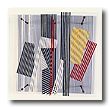The Blanton Museum of Art,
Feb 20, 2007 - Apr 22, 2007
Austin, USA
The Geometry of Hope
by María Amalia García
The catalogue as well sets itself apart from previous editions. This book brings together introductory texts concerning the artistic activity of the cities under scrutiny (the works of Pérez-Barreiro on Buenos Aires and the one by Luis Pérez-Oramas on Caracas stand out) along with contextual and interpretative analyses of the works. This editorial approach is based on the need to establish specific visual analyses that will account for the physical evidence of objects and their problematic character. Unquestionably, at a moment when, as Pérez-Barreiro points out, abstract Latin-American art is increasingly collected and exhibited, it becomes necessary to reach an agreement pertaining to coherent cataloguing criteria that will allow the works to be precisely dated, showing the differences between the initial projects and subsequent reconstructions of the same.
Equally recent at the institutional level is the articulation between the Cisneros Foundation and the American university structure. This exhibit is the final product of the Cisneros Research Seminar on Abstraction and Contemporary Art carried out at the Blanton Museum during 2005-06. This seminar featured the presence of a number of researchers, artists, and curators from different academic and museum fields; in this respect, participation by Andrea Giunta and Luis Camnitzer should be mentioned.
Lastly, I would like to mention the symposium that took place on February 17 at the time of the exhibit’s inauguration. First, curators from the Cisneros Collection, Luis Pérez-Oramas and Ariel Jiménez, read their papers on Soto and Otero, respectively. In the course of the following panel of discussion, new research by doctoral students was discussed pertaining to matters related to the exhibit: Juan Carlos Ledezma, Ana Pozzi-Harris, Adele Nelson and yours truly. The presentations were commented upon by Andrea Giunta and Jacqueline Barnitz.
The Geometry of Hope thus advances a curatorial model for thinking about Latin American abstraction. The concept of city, inasmuch as it is an offshoot of a network articulating regional and international projects, is formulated as a comprehensive devise for capturing the meanings that abstraction has had in Latin America. In this respect, the exhibit does not intend to fasten on any specific dialogical direction but to advance open itineraries. In order to get to know a city one is called upon to tread its various paths.
NOTES:
(1) I here refer to Paralelos, Museu de Arte Moderna Sao Paulo and Museu de Arte Moderna, Rio de Janeiro, 2002.
(2) Reflection upon these themes results from studying the works of Raymond Williams, Sociología de la cultura (Barcelona, Paidós, 1994: Sociology of Culture) and of Susan Buck-Morss, Mundo soñado y catástrofe. La desaparición de la utopía de masas en el Este y el Oeste (Madrid, La balsa de la Medusa, 2004: The World Dreamed and Catastrophe. The Disappearance of Mass Utopia in East and West.).
(3) Ferreira Gullar, "Manifesto Neoconcreto", Jornal do Brasil, Rio de Janeiro, March 22, 1959.
|

![Estudio 2 [Study 2] by Alejandro Otero](images/ve_otero_02_md.jpg)

![Idéia visível [Visible Idea] by Waldemar Cordeiro](images/br_corde_01_md.jpg)
![Ritmos cromáticos III [Chromatic Rhythms III] by Alfredo Hilto](images/ar_ hilto_02_md.jpg)
![Ritmos cromáticos III [Chromatic Rhythms III] by Alfredo Hilto](images/uy_torre_19_im.jpg)


